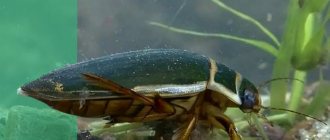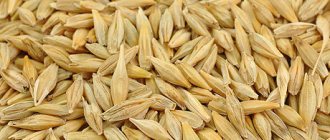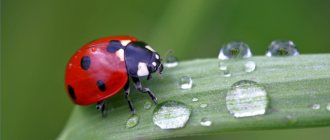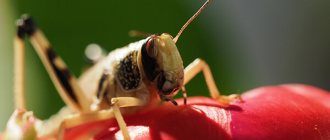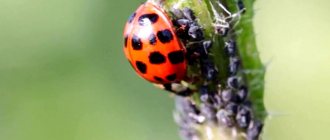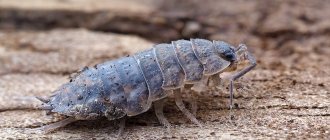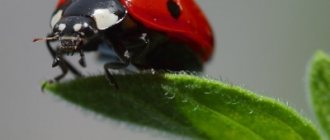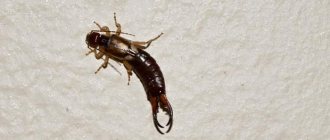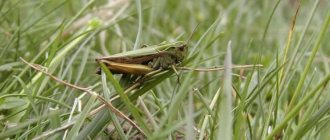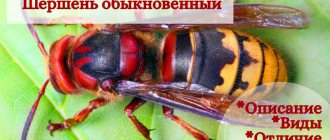- Wild animals
- >>
- Insects
Almost everyone who rested on the shore of a lake or river came across a swimming beetle . This dexterous insect is a merciless predator and attacks many river creatures. These beetles do not show aggression towards humans, but if they feel threatened, they can bite. The bite of a diving beetle is not life-threatening, but quite painful.
Origin of the species and description
Photo: Swimming beetle
The swimming beetle is a representative of the family of aquatic insects from the large order Coleoptera. In total, there are about 4,000 species of these creatures, 300 of them are found in Russia. The beetle's Latin name, Dytiscus, translates to "diving." The oldest fossil of this insect was found in Kazakhstan and dates back to the Jurassic period.
Video: Swimming beetle
From the whole variety of swimming beetles, several of the most interesting species to study can be identified:
- the fringed beetle is the most common and largest. Its body is painted black with a characteristic orange border, its legs are also very bright;
- a wide swimming beetle - its main feature is that the larvae are larger in size than adults and can grow up to 6 cm in length;
- The color of the wide diving beetles is inconspicuous - from dark brown to black with a greenish tint. In some countries it is listed in the Red Book;
- striper or phalarope - small in size, quite common in Russia;
- The diving beetle is the smallest representative of the diving beetles. There is a swamp and flat diving. The body of the first is covered with stiff hairs.
Interesting fact: Swimming beetle larvae digest food outside their bodies using a special poisonous liquid that is injected into the victim. The larvae suck out the nutrients from it in a completely digested form.
Interesting Facts
There is an opinion that the diving beetle chooses weak and sick inhabitants of the pond as victims for attack, that is, it is, in fact, an orderly. The diving beetle usually does not show hostility towards a person who finds himself in the same water pool. But the bite is very painful even for a person.
The sharp pain associated with the bite may go away after some time, but swelling occurs in the bitten area, completely disappearing after 14-20 days. The wounded area must be washed, treated with disinfectants, bandaged and a cold compress applied.
Most often, beetles show aggressiveness towards those who try to catch them and pick them up. At home, experts do not recommend keeping swimming beetles and ornamental fish in the same aquarium, as the predator will attack them and can seriously injure them.
Swimming beetles are a large (more than 4 thousand species) family of aquatic beetles that live in almost all regions of the world except the driest ones. Some are even able to live under ice. Many of them are freshwater predators. The scientific name of the insect is Dytiscidae. The term comes from the ancient Greek word dytikos, meaning "one who loves to dive."
Appearance and features
Photo: What a swimming beetle looks like
The size of adult swimming beetles and color may vary depending on the species. The length of the body of the smallest specimens does not exceed 3-4 mm, large specimens reach 4.5-5.5 cm. The body of the adult is oval and flat, which is ideal for movement under water. The hind limbs have well-developed muscles. The flattened tibiae and hind legs are covered with elastic hairs. The method of movement in the water column itself is similar to rowing with oars. The front and middle legs of the beetle are much shorter than the hind legs.
The swimmer's body consists of three parts: head, chest, and abdomen. The head is fixed on the chest, motionless and extends onto the abdomen without clear boundaries. On the sides of the wide and flat head there are quite large eyes and each of them consists of 9000 ordinary ocelli, thanks to which the insect is able to clearly distinguish between moving and static objects. The beetle's abdomen consists of eight segments, which are protected by hard elytra.
The powerful jaw is located behind the upper lip. The mouthparts are of the gnawing type, the jaw is designed for grasping and rapid chewing. The organ of smell is a segmented long mustache of 11 segments. Swimming bells breathe using special holes located on their belly. A complex system of tracheae extends from the spiracles, and there are air sacs in the chest. By opening and contracting its abdomen, the swimmer creates air movement in the trachea.
The body color of the diving beetle larvae can be brown, yellow, gray, and sometimes the body is covered with a pattern. Young beetles are very similar to scorpions. Their head is flattened, the chest consists of three segments, and the belly consists of 8 segments. There is no mouth opening and food enters through the jaw. The wide body gradually tapers towards the posterior end, on which there are cerci, spines and setae.
Rules for aquarists
Tips for beginner aquarists:
- Watch the behavior and appearance of the fish. The color should be rich, the eyes should not be cloudy. If you have any suspicions, contact experienced aquarists, describing in detail the problem, the parameters of the aquarium and the features of keeping the fish.
- Keep in mind that even in a healthy aquarium, in addition to plants and fish, other small inhabitants appear (for example, ciliates or small insects).
- Maintain your aquarium on time. Incomplete care of the aquarium stimulates fish poisoning and decreased immunity.
- When introducing new fish, study information about them. They may be incompatible in terms of required water parameters or temperament.
- If the fish dies, immediately remove the corpse from the water. Determine the cause of death by external examination.
- If the fish shows signs of illness, place it in a separate container.
- Do not knock on the glass or interfere with the life of the inhabitants of your home aquarium unless necessary.
- When you start breeding fish, learn what you can’t do without for successful spawning, and how many males a female is placed with.
- To avoid damaging the walls of the aquarium, use a non-metallic scraper.
- If stones are collected from the street, test them for the presence of heavy metal ions with acetic or citric acid. Stones containing undesirable elements will react when they come into contact with acid. Boil the soil thoroughly to avoid introducing parasites into the aquarium. Driftwood collected from nature must also be thoroughly boiled.
- To prevent fish from jumping out of the aquarium, cover the container with a lid.
- Proper use of an aquarium siphon, connecting equipment or feeding fish is impossible without training and preparation, it will take a little patience before the aquarium hobby becomes productive.
Science points to fish's ability to sense and recognize faces. Aquatic pets have their own characteristics and range of sensations. Don’t be lazy to create comfort in the world of underwater inhabitants, because fish are sensitive and intelligent creatures.
Previous Aquarium Daily feeding using feeders for aquarium fish Next Aquarium Is it enough for the aquarium water to stand for just a few hours?
Where does the swimming beetle live?
Photo: Swimming beetle in water
Swimming beetles are widespread throughout the world, they are found in Europe, Asia, over a vast territory from Sakhalin to the Atlantic Ocean, and northern Africa. Swimming beetles prefer fresh water bodies where there is no current or it is very weak. They are found in abundance in ponds with stagnant, blooming water, and swamps.
The beetle spends most of its time underwater, but can also fly—if necessary, insects travel tens of kilometers. Most often, beetles are forced to make such flights by the drying out of a reservoir or a small amount of food. Sometimes they can even fly into private pools and ponds where ornamental and other fish are bred.
They are capable of completely destroying fry and all other living creatures in an artificial reservoir. It can be quite difficult to drive them away from their favorite place. In some cases, only complete disinfection of the bottom of the reservoir and re-breeding its inhabitants can help.
Interesting fact: The swimming beetle takes root well even in aquariums. Meat can be used as food, which is pre-cut into small pieces. The aquarium must be covered with a lid, as insects can easily fly away. The main condition is that beetles cannot be placed in the same container with any fish.
Undesirable neighborhood
Having settled in a decorative pond, a predatory beetle attacks decorative fish and other inhabitants. Owners of ponds are faced with a difficult problem: how to get rid of the swimming beetle in the pond? The least labor-intensive way is to have crucian carp, which actively destroy the larvae of the swimming beetle. Another option is to temporarily install a pump or fountain that creates movement of the water mass. The insect prefers stagnant bodies of water, so it will leave its shelter and go in search of a better habitat.
If the above methods do not work, then all that remains is to drain the water, clean and disinfect the bottom. This will destroy the adults and larvae of the beetle. After treatment, water is poured in and new inhabitants are released.
Danger to humans
You can encounter a predatory beetle while swimming in a lake or in your own pool. The insect shows aggression towards humans extremely rarely. The bite is painful, but does not pose a threat to health. The swimming beetle bites in the water if it feels threatened. The pain from the skin puncture remains for several minutes. After some time, the wound swells and a lump may form. The beetles are not poisonous, so there is no allergic reaction.
The victim must be given first aid:
- wash the wound;
- treat with an antiseptic (iodine, hydrogen peroxide);
- apply a bandage;
- apply ice to relieve swelling.
Attention. Often, those who pick it up without the necessary skill get bites from the swimming beetle.
What does the swimming beetle eat?
Photo: Water beetle
Swimming beetles are fierce predators. Adults rarely feed on carrion; they are more attracted to live prey that will resist.
The main diet of swimming beetles:
- insects and their larvae, snails, tadpoles, fish fry;
- newts, frogs, small fish.
Beetles are not interested in algae; they are completely carnivorous. If there are a lot of these insects in a reservoir, then in a short period of time they are able to destroy all the fish, attacking their fry in large groups. The beetles sense even a small drop of blood at a distance of tens of meters and immediately rush to this place. They look for food mainly only in the water column and rarely go to land.
Interesting fact: Swimming beetles eat a lot. Sometimes they overeat so much that they are not even able to rise to the surface of the reservoir. In order to reduce body weight and float to the surface, the swimmer regurgitates everything recently eaten, completely empties the intestines and a special crop. When there are algae nearby, it slowly rises to the surface of the reservoir along them.
The larvae of diving beetles differ little from adult individuals in their predatory instincts. They are capable of attacking quite large fish; they bite very painfully if they fall into the hands of a person. Their jaws are incredibly sharp, similar to sabers.
Lifestyle
Beetles settle in fresh, stagnant water or bodies of water with weak currents and a lot of vegetation. The fringed swimmer is rarely seen in shallow waters. Adults prefer to leave the pond at night. They make long flights in search of new favorable habitats. Before takeoff, the intestines are emptied and filled with air. When landing, they simply fall head first. The lifespan of a male is 1 year, a female is 1.5-2 years.
Predatory adults attack any prey of suitable size: insects, snails, newts, tadpoles and fish fry. Cannibalism often occurs, with adult beetles eating their own larvae. They consume not only live prey, but also dead animals floating in the water. The green color of the body makes the hunter invisible among the plants. It quickly rushes at passing victims. Insects and tadpoles are torn apart by strong jaws and eaten completely. After feeding, swimmers clean their mouth parts with their front paws.
Beetles are extremely voracious; they rush to available prey, even when well-fed. Promiscuity sometimes leads to death; for example, ladybird larvae are poisonous to them. The fringed swimmer is capable of fasting for 1-2 months.
Breathing process
Adults breathe atmospheric air. To replenish its reserves stored under the elytra, the beetle exposes the rear end of its abdomen above the surface of the water. Through the spiracles, air enters the tracheal system. If it is not possible to surface, swimmers use oxygen dissolved in the water. They expose an air bubble from under the elytra. Gas exchange occurs through its walls, then the bubble is retracted. This is inferior breathing; it does not replace atmospheric air.
Reproduction
The mating period begins in the spring, after emerging from hibernation. The male climbs onto the female and is held on her elytra using flat discs with suction cups on the front legs. During copulation, it has the ability to stick its abdomen out of the water and breathe. Saka is deprived of such an opportunity. If she is attacked by several males, then after the second or third mating she dies from suffocation. The only available way to obtain oxygen is to release a bubble for gas exchange in water. If fertilization occurs in the fall, the resulting sperm retain the ability to fertilize for six months.
In April-May, eggs begin to be laid on the stems and leaves of aquatic plants. Laying is done by young females who have wintered twice. The eggs are placed inside plant tissues using a sharp ovipositor. Up to 30 eggs are laid in one day, and 1000 eggs are laid over the entire period. The clutch is placed on any plants that the female encounters, such as reeds, marigolds, and arrowheads. Clumps of seaweed can be used. The eggs are large, 6-7 mm in size, light yellow. The plant protects them from being eaten and mechanical damage.
Larval development
The hatched larva is completely different from the imago. Coming out of the egg, it falls to the bottom, where it rests for 30-40 minutes. Then it vigorously rises to the surface and takes its first breath using the spiracles at the end of the abdomen. It is born 10 mm long, and by the end of development it increases 5 times. The larva has a flattened head, curved upper jaws, and an elongated prothorax. Three pairs of swimming legs help to move quickly. The abdomen consists of 8 segments. The latter has caudal appendages, anus and spiracles.
The diving beetle larva is no less dangerous a predator than its parents. With strong curved jaws, it securely holds the prey, preventing it from escaping. Through channels located in the mandibles, toxic liquid from the larval esophagus enters the victim’s body. It is rich in enzymes that convert protein into a liquid state. The little huntress sucks out the nutritious pulp, leaving only the skin. At a low temperature of +4°C the larvae stop feeding. Fasting can last for several weeks.
Doll
Approaching the final stage of development, the larva becomes restless and changes in appearance. She crawls onto land and looks for a hole for pupation. The larva builds a spherical cradle from the earth and its own secretions. The pupal phase lasts 2-4 weeks. Young beetles are painted white. Within a few hours, parts of their body first turn yellow, then acquire a dark shade with a yellow border around the edge.
Having emerged from the ground, the swimmer crawls towards the water. An interesting insect is often kept in aquariums. Beetles do not require special care and are unpretentious in nutrition. In captivity they live 3-4 years.
Features of character and lifestyle
Photo: Large swimming beetle
The body of swimmers is lighter than water and, if they have not overfed, they rise to the surface very easily. It takes a lot of effort to get down. At the bottom of the reservoir, on the surface of the algae, the beetles are held with the help of special hooks on the forelimbs.
These insects actively hunt at night. If the living conditions in the reservoir do not satisfy them, then they go in search of another home and are able to travel long distances. Before starting the journey, the adult completely empties its intestines and then fills its air sacs. Only by removing as much as possible everything unnecessary and reducing its weight does the swimmer take off. During a night flight, many beetles crash against the glossy surfaces of roofs and walls of buildings, as they mistake them for a body of water.
The majority of swimming beetles spend the winter in the soil or hide in cracks in the bark of trees. Some insects overwinter in the egg phase, others as larvae. Some adults remain in the water and actively swim until it freezes. When ice sets in, insects burrow into the silt until spring.
Interesting fact: To replenish oxygen supplies, the beetle floats to the surface and sticks its abdomen above the water. An adult beetle should carry out this procedure at least once every 15 minutes. Air is used by beetles not only for breathing, but also for controlling ascent and descent.
Social structure and reproduction
Photo: Swimming beetle in a pond
Immediately after hibernation, swimmers begin to reproduce. Males do not court females; they themselves choose a suitable individual and simply attack it, grabbing it with their front paws, and immediately begin mating. The entire process takes place underwater. At one time, a female can mate with several males, and some of them die from suffocation due to the lack of opportunity to replenish air supplies once again. Males at this time are above the surface of the water.
After the mating process is complete, the females lay their eggs inside the algae, first piercing the tissue with the ovipositor. In one season, the female lays 1-1.5 thousand eggs. After 10-12 days the larvae appear. Depending on the weather, the process may take up to a month.
Swimming beetle larvae grow very quickly. They are excellent swimmers, capable of breathing atmospheric air, like adults, but they expose the rear end of their body for this. Larvae, like adult beetles, are very voracious and merciless predators. Their first food: fish eggs, larvae of dragonflies, caddis flies, and mosquitoes.
With the onset of autumn, the larvae of diving beetles leave water bodies and crawl to the shore, where they build themselves cradles from soil and plants. In such a shelter their pupation occurs. After a month, adults appear. At first they are white and soft like dolls, but within a few hours their surface hardens and darkens.
Insect lifestyle
Despite the fact that the beetle can fly, it practically does not leave the reservoir if there is enough food for it. At the same time, it quite often rises to the surface of the water to stock up on oxygen. To do this, the beetle has a special place that is filled with air; it is enough for it to expose the back of its body from the water.
In winter, especially in severe cold conditions. The swimming beetle does not show any activity while in a state of suspended animation. To do this, insects dig special holes in the ground where they wait out the cold.
Natural enemies of the swimming beetle
Photo: What a swimming beetle looks like
The adult diving beetle lives on average 1-2 years. During their rather short life, these creatures are capable of causing great damage to the ecosystem of a reservoir and fish farms. If it were not for the natural enemies of the predatory beetle, it would be very difficult to control its numbers.
The diving beetle can be hunted by:
- large fish species;
- some birds, including all seagulls;
- mammals that inhabit bodies of water.
In case of danger, swimmers are capable of quickly producing a special white secretion with a pungent odor, which scares away some predators who decide to feast on them. For this reason, there are not many people who want to attack her.
The parasitic wasp is a natural enemy of predatory beetle larvae. Female ichneumon wasps purposefully search for swimming beetle larvae by their special smell and lay their eggs inside their bodies, which then feed and pupate right inside the larvae. As they grow, the young diving beetles die.
Interesting fact: The predatory beetle, despite its small size, is able to cope with prey that is three times larger than the predator itself. If one individual is unable to control the prey, then other beetles rush to its aid - like piranhas, they only need to smell blood in the water column.
The meaning of swimming beetles in nature
Members of the diving beetle family can be both beneficial and harmful. For example, the diet of some large species consists of small fish and fry. In the event of a significant increase in the number of predatory insects, the population of many fish may be under threat.
As for the benefits, there are several species of swimming beetles that massively eat the larvae of dipterous harmful insects. In addition, many species included in the diet of these beetles are carriers of a dangerous infection - malaria.
